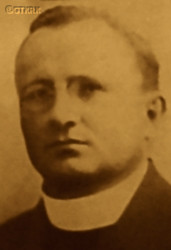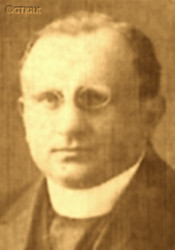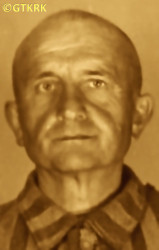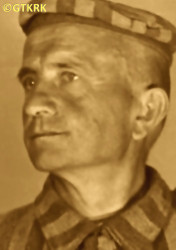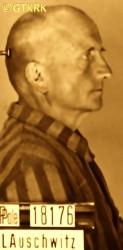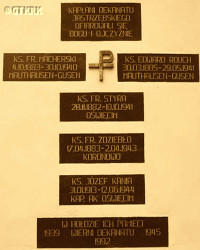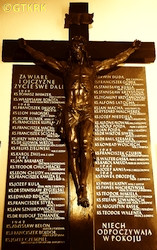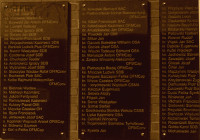Roman Catholic
St Sigismund parish
05-507 Słomczyn
85 Wiślana Str.
Konstancin deanery
Warsaw archdiocese, Poland
full list:
displayClick to display full list

searchClick to search full list by categories
wyświetlKliknij by wyświetlić pełną listę po polsku

szukajKliknij by przeszukać listę wg kategorii po polsku

Martyrology of the clergy — Poland
XX century (1914 – 1989)
personal data
surname
STYRA
forename(s)
Francis (pl. Franciszek)
function
diocesan priest
creed
Latin (Roman Catholic) Church RCmore on
en.wikipedia.org
[access: 2014.09.21]
diocese / province
Katowice diocesemore on
en.wikipedia.org
[access: 2013.05.19]
Wrocław diocesemore on
en.wikipedia.org
[access: 2013.05.19]
date and place
of death
10.10.1941

KL Auschwitzconcentration camp
today: Oświęcim, Oświęcim gm., Oświęcim pov., Lesser Poland voiv., Poland
more on
en.wikipedia.org
[access: 2022.01.09]
details of death
In 1919‐1921, after Poland regained independence in 11.1918, during preparations for a plebiscite that was to decide national destiny of Upper Silesia and Opole region, and during Silesian uprising supported Polish cause.
After German and Russian invasion of Poland in 09.1939 and start of the World War II, after start of German occupation, arrested on 15.04.194 by the Germans, prob. for lending a typewriter used to print clandestine resistance leaflets.
Jailed in Rybnik prison.
From there on 17.07.1941 transported to KL Auschwitz concentration camp, where perished — beaten up by a barrack guard had a surgery on wounded leg, a gangrene set in and contracted pneumonia.
prisoner camp's numbers
18176Click to display source page (KL AuschwitzClick to display the description)
cause of death
extermination: exhaustion and starvation
perpetrators
Germans
sites and events
KL AuschwitzClick to display the description, RybnikClick to display the description, Regierungsbezirk KattowitzClick to display the description, Ribbentrop‐MolotovClick to display the description, Pius XI's encyclicalsClick to display the description, Silesian UprisingsClick to display the description
date and place
of birth
28.11.1882

Biedrzychowicetoday: Głogówek gm., Prudnik pov., Opole voiv., Poland
more on
en.wikipedia.org
[access: 2022.02.14]
parents
STYRA Joseph
🞲 ?, ? — 🕆 ?, ?

MICZEK Pauline
🞲 ?, ? — 🕆 ?, ?
presbyter (holy orders)
ordination
22.06.1907

Wrocławtoday: Wrocław city pov., Lower Silesia voiv., Poland
more on
en.wikipedia.org
[access: 2021.04.02]
positions held
1924 – 1941
parish priest — Mszanatoday: Mszana gm., Wodzisław Śląski pov., Silesia voiv., Poland
more on
en.wikipedia.org
[access: 2022.05.23] ⋄ St George the Martyr RC parish ⋄ Wodzisław Śląskiform.: Wodzisław
today: Wodzisław Śląski urban gm., Wodzisław Śląski pov., Silesia voiv., Poland
more on
en.wikipedia.org
[access: 2021.12.18] RC deanery
1922 – 1924
vicar — Mszanatoday: Mszana gm., Wodzisław Śląski pov., Silesia voiv., Poland
more on
en.wikipedia.org
[access: 2022.05.23] ⋄ St George the Martyr RC parish ⋄ Wodzisław Śląskiform.: Wodzisław
today: Wodzisław Śląski urban gm., Wodzisław Śląski pov., Silesia voiv., Poland
more on
en.wikipedia.org
[access: 2021.12.18] RC deanery
1922
vicar — Rybniktoday: Grabów gm., Łęczyca pov., Łódź voiv., Poland
more on
pl.wikipedia.org
[access: 2022.01.28] ⋄ RC parish
1919 – 1922
vicar — Ujazdtoday: Ujazd gm., Strzelce Opolskie pov., Opole voiv., Poland
more on
en.wikipedia.org
[access: 2021.04.02] ⋄ St Andrew the Apostle RC parish ⋄ Ujazdtoday: Ujazd gm., Strzelce Opolskie pov., Opole voiv., Poland
more on
en.wikipedia.org
[access: 2021.04.02] RC deanery
1917 – 1919
vicar — Bieruń Starytoday: district of Bieruń, Bieruń urban gm., Bieruń‐Lędziny pov., Silesia voiv., Poland
more on
en.wikipedia.org
[access: 2020.11.05] ⋄ St Bartholomew the Apostle RC parish ⋄ Mikołówtoday: Mikołów urban gm., Mikołów pov., Silesia voiv., Poland
more on
en.wikipedia.org
[access: 2021.12.18] RC deanery
1911 – 1917
vicar — Gliwicetoday: Gliwice city pov., Silesia voiv., Poland
more on
en.wikipedia.org
[access: 2021.04.02] ⋄ St Peter and St Paul the Apostles RC parish ⋄ Gliwicetoday: Gliwice city pov., Silesia voiv., Poland
more on
en.wikipedia.org
[access: 2021.04.02] RC deanery
1910 – 1911
vicar — Przyszowicetoday: Gierałtowice gm., Gliwice pov., Silesia voiv., Poland
more on
en.wikipedia.org
[access: 2022.07.16] ⋄ St John of Nepomuk the Martyr RC parish ⋄ Dębieńskotoday: district of Czerwionka‐Leszczyny, Czerwionka‐Leszczyny gm., Rybnik pov., Silesia voiv., Poland
more on
en.wikipedia.org
[access: 2020.11.27] RC deanery
1907 – 1910
vicar — Kochłowicetoday: district of Ruda Śląska, Ruda Śląska city pov., Silesia voiv., Poland
more on
en.wikipedia.org
[access: 2021.04.02] ⋄ Holy Trinity RC parish ⋄ Królewska Hutatoday: Chorzów /from 1934/, Chorzów city pov., Silesia voiv., Poland
more on
en.wikipedia.org
[access: 2021.12.18] RC deanery
till 1907
student — Wrocławtoday: Wrocław city pov., Lower Silesia voiv., Poland
more on
en.wikipedia.org
[access: 2021.04.02] ⋄ philosophy and theology, Department of Catholic Theology, University of Wrocław [i.e. University of Wrocław (since 1945) / Frederic Wilhelm University of Silesia (1911‐1945) / Royal University i.e. Breslau Academy (1816‐1911)]
sites and events
descriptions
KL Auschwitz: German Germ. Konzentrationslager (Eng. concentration camp) KL and Germ. Vernichtungslager (Eng. extermination camp) VL Auschwitz was set up by Germans around 27.01.1940 n. Oświęcim, on the German territory (initially in Germ. Provinz Schlesien — Silesia Province; and from 1941 Germ. Provinz Oberschlesien — Upper Silesia Province). Initially mainly Poles were interned. From 1942 it became the centre for holocaust of European Jews. Part of the KL Auschwitz concentration camps’ complex was Germ. Vernichtungslager (Eng. extermination camp) VL Auschwitz II Birkenau, located not far away from the main camp. There Germans murder possibly in excess of million people, mainly Jews, in gas chambers. Altogether In excess of 400 priests and religious went through the KL Auschwitz, approx. 40% of which were murdered (mainly Poles). (more on: en.auschwitz.org.plClick to attempt to display webpage
[access: 2012.11.23], www.meczennicy.pelplin.plClick to attempt to display webpage
[access: 2013.07.06])
Rybnik: Detention centre run by Germans.
Regierungsbezirk Kattowitz: After the Polish defeat in the 09.1939 campaign, which was the result of the Ribbentrop‐Molotov Pact and constituted the first stage of World War II, and the beginning of German occupation in part of Poland (in the other, eastern part of Poland, the Russian occupation began), the Germans divided the occupied Polish territory into five main regions (and a few smaller). The largest one was transformed into Germ. Generalgouvernement (Eng. General Governorate), intended exclusively for Poles and Jews and constituting part of the so‐called Germ. Großdeutschland (Eng. Greater Germany). From two separate new provinces were created. The two remaining were incorporated into existing German provinces. One of those was Polish Upper Silesia, which on 08.09.1939, by decree of the German leader Adolf Hitler (formally came into force on 26.10.1939), was incorporated into Germany as the Germ. Regierungsbezirk Kattowitz (Eng. Katowice Regency) and became part of the Germ. Provinz Schlesien (Eng. Province of Silesia) based in Wrocław. On 01.04.1940, the Germ. Regierungsbezirk Kattowitz was enlarged by several pre‐war German counties, and on 18.01.1941, a new German province was created, the Germ. Provinz Oberschlesien (Eng. Province of Upper Silesia), which, apart from the Germ. Regierungsbezirk Kattowitz, also included the Opole region. From 26.10.1939, when the regency was established, the law of the German state was in force there, the same as in Berlin. The main axis of the policy of the new regency, the territory of which the Germans recognized as the Germ. „Ursprünglich Deutsche” (Eng. „natively German”), despite the fact only 6% of its pre–war Polish part were Germans, was Germ. „Entpolonisierung” (Eng. „Depolonisation”), i.e. forced Germanization. The main mechanism was the introduction of the Germ. Deutsche Volksliste DVL, a German nationality list that was supposed to specify the national affiliation of the inhabitants of the region. The largest group marked in the compulsory registrations was Group 3, people who identified themselves as „Silesians” (in 1943 about 41%), and people remaining outside the DVL (about 36%). The latter group was intended to be deported to the Germ. Generalgouvernement (which did not happen en masse because German industry needed slave labor). Group 3, considered by the Germans as capable of Germanization, was subject to certain legal restrictions, and was subject to, among others, to conscription into the German Wehrmacht army. Children could only learn in German. A policy of terror was pursued against the Polish population. There was a special police court, controlled by the Germ. Geheime Staatspolizei (Eng. Secret State Police), i.e. the Gestapo, before which c. 4,000‐5,000 people were detained. For the years 1942‐1945 over 2,000 of them were verified, of which 1,890 were sentenced to death, including 286 in public executions. Thousands of people were murdered during the so‐called «Intelligenzaktion Schlesien», including 300‐650 Polish teachers and c. 61 Polish Catholic priests. The regency hosted a German concentration and extermination camp KL Auschwitz, where the Germans imprisoned c. 1,100,000 Jews (murdering c.1,000,000, i.e. c. 90% of them) and c. 140,000 Poles (murdering c. 70,000, i.e. c. 50% of them). After the end of hostilities of World War II, the overseer of this province, the Germ. Reichsstatthalter (Eng. Reich Governor) and the Germ. Gauleiter (Eng. district head) of the German National Socialist Party, Fritz Brecht, committed suicide. (more on: en.wikipedia.orgClick to attempt to display webpage
[access: 2024.06.24])
Ribbentrop‐Molotov: Genocidal Russian‐German alliance pact between Russian leader Joseph Stalin and German leader Adolf Hitler signed on 23.08.1939 in Moscow by respective foreign ministers, Mr. Vyacheslav Molotov for Russia and Joachim von Ribbentrop for Germany. The pact sanctioned and was the direct cause of joint Russian and German invasion of Poland and the outbreak of the World War II in 09.1939. In a political sense, the pact was an attempt to restore the status quo ante before 1914, with one exception, namely the „commercial” exchange of the so‐called „Kingdom of Poland”, which in 1914 was part of the Russian Empire, fore Eastern Galicia (today's western Ukraine), in 1914 belonging to the Austro‐Hungarian Empire. Galicia, including Lviv, was to be taken over by the Russians, the „Kingdom of Poland” — under the name of the General Governorate — Germany. The resultant „war was one of the greatest calamities and dramas of humanity in history, for two atheistic and anti‐Christian ideologies — national and international socialism — rejected God and His fifth Decalogue commandment: Thou shall not kill!” (Abp Stanislav Gądecki, 01.09.2019). The decisions taken — backed up by the betrayal of the formal allies of Poland, France and Germany, which on 12.09.1939, at a joint conference in Abbeville, decided not to provide aid to attacked Poland and not to take military action against Germany (a clear breach of treaty obligations with Poland) — were on 28.09.1939 slightly altered and made more precise when a treaty on „German‐Russian boundaries and friendship” was agreed by the same murderous signatories. One of its findings was establishment of spheres of influence in Central and Eastern Europe and in consequence IV partition of Poland. In one of its secret annexes agreed, that: „the Signatories will not tolerate on its respective territories any Polish propaganda that affects the territory of the other Side. On their respective territories they will suppress all such propaganda and inform each other of the measures taken to accomplish it”. The agreements resulted in a series of meeting between two genocidal organization representing both sides — German Gestapo and Russian NKVD when coordination of efforts to exterminate Polish intelligentsia and Polish leading classes (in Germany called «Intelligenzaktion», in Russia took the form of Katyń massacres) where discussed. Resulted in deaths of hundreds of thousands of Polish intelligentsia, including thousands of priests presented here, and tens of millions of ordinary people,. The results of this Russian‐German pact lasted till 1989 and are still in evidence even today. (more on: en.wikipedia.orgClick to attempt to display webpage
[access: 2015.09.30])
Pius XI's encyclicals: Facing the creation of two totalitarian systems in Europe, which seemed to compete with each other, though there were more similarities than contradictions between them, Pope Pius XI issued in 03.1937 (within 5 days) two encyclicals. In the „Mit brennender Sorge” (Eng. „With Burning Concern”) published on 14.03.1938, condemned the national socialism prevailing in Germany. The Pope wrote: „Whoever, following the old Germanic‐pre‐Christian beliefs, puts various impersonal fate in the place of a personal God, denies the wisdom of God and Providence […], whoever exalts earthly values: race or nation, or state, or state system, representatives of state power or other fundamental values of human society, […] and makes them the highest standard of all values, including religious ones, and idolizes them, this one […] is far from true faith in God and from a worldview corresponding to such faith”. On 19.03.1937, published „Divini Redemptoris” (Eng. „Divine Redeemer”), in which criticized Russian communism, dialectical materialism and the class struggle theory. The Pope wrote: „Communism deprives man of freedom, and therefore the spiritual basis of all life norms. It deprives the human person of all his dignity and any moral support with which he could resist the onslaught of blind passions […] This is the new gospel that Bolshevik and godless communism preaches as a message of salvation and redemption of humanity”… Pius XI demanded that the established human law be subjected to the natural law of God , recommended the implementation of the ideal of a Christian state and society, and called on Catholics to resist. Two years later, National Socialist Germany and Communist Russia came together and started World War II. (more on: www.vatican.vaClick to attempt to display webpage
[access: 2023.05.28], www.vatican.vaClick to attempt to display webpage
[access: 2023.05.28])
Silesian Uprisings: Three armed interventions of the Polish population against Germany in 1919‐1921 aiming at incorporation of Upper Silesia and Opole region into Poland, after the revival of the Polish state in 1918. Took place in the context of a plebiscite ordered on the basis of the international treaty of Versailles of 28.06.1919, ending the First World War, that was to decide national fate of the disputed lands. The 1st Uprising took place on 16‐24.08.1919 and broke out spontaneously in response to German terror and repression against the Polish population. Covered mainly Pszczyna and Rybnik counties and part of the main Upper Silesia industrial district. Suppressed by the Germans. 2nd Uprising took place on 19‐25.08.1920 in response to numerous acts of terror of the German side. Covered the entire area of the Upper Silesia industrial district and part of the Rybnik county. As a result Poles obtained better conditions for the campaign prior the plebiscite. The poll was conducted on 20.03.1921. The majority of the population — 59.6% — were in favor of Germany, but the results were influenced by the admission of voting from former inhabitants of Upper Silesia living outside Silesia. As a result the 3rd Uprising broke out, the largest such uprising of the Silesian in the 20th century. It lasted from 02.05.1921 to 05.07.1921. Spread over almost the entire area of Upper Silesia. Two large battles took place in the area of St. Anna Mountain and near Olza. As a result on 12.10.1921 the international plebiscite commission decided on a more favorable for Poland division of Upper Silesia. The territory granted to Poland was enlarged to about ⅓ of the disputed territory. Poland accounted for 50% of metallurgy and 76% of coal mines. (more on: en.wikipedia.orgClick to attempt to display webpage
[access: 2020.05.25])
sources
personal:
encyklo.plClick to attempt to display webpage
[access: 2021.12.19], www.harmeze.franciszkanie.plClick to attempt to display webpage
[access: 2012.12.28], www.rybnik.plClick to attempt to display webpage
[access: 2013.05.19]
original images:
encyklo.plClick to attempt to display webpage
[access: 2021.12.19], encyklo.plClick to attempt to display webpage
[access: 2016.05.30], encyklo.plClick to attempt to display webpage
[access: 2016.05.30], www.auschwitz.orgClick to attempt to display webpage
[access: 2018.11.18], www.katowice.uw.gov.plClick to attempt to display webpage
[access: 2014.01.06], www.harmeze.franciszkanie.plClick to attempt to display webpage
[access: 2014.03.21]
LETTER to CUSTODIAN/ADMINISTRATOR
If you have an Email client on your communicator/computer — such as Mozilla Thunderbird, Windows Mail or Microsoft Outlook, described at WikipediaPatrz:
en.wikipedia.org, among others — try the link below, please:
LETTER to CUSTODIAN/ADMINISTRATORClick and try to call your own Email client
If however you do not run such a client or the above link is not active please send an email to the Custodian/Administrator using your account — in your customary email/correspondence engine — at the following address:

giving the following as the subject:
MARTYROLOGY: STYRA Francis
To return to the biography press below:
 Click to return to biography
Click to return to biography








